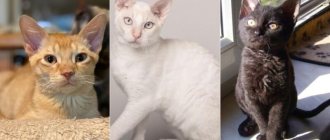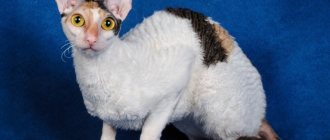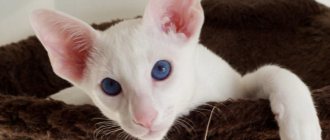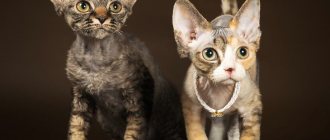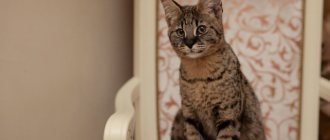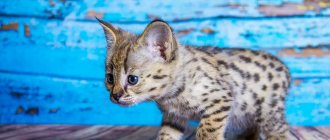Cats are chosen primarily based on their appearance. But often this approach leads to the fact that the pet does not match the owner in temperament. A detailed description of the Cornish Rex breed will help you avoid mistakes when choosing a pet.
Just imagine - living in the same apartment for 15 years with a cat whose manners and behavior irritate you! Caring for a pet becomes a burden, and more and more often thoughts appear in your head that it would be better without a cat. To avoid such a sad scenario, you need to collect as much information as possible about the cat breed that has caught your attention.
Cornish Rex dogs have loyal fans in every country in the world. Cornish fans believe that this is the ideal cat. Why then did curly-haired pets not become as fabulously popular as the British, Siamese, and Persians were in their time? Rexes remain a fairly rare and little-known breed. Let's talk about the features of these unusual animals.
Author of the article: Olga Shiltsova, practicing veterinarian, author of the books “Dachshund of Fate” and “Tails of Fortune”
Appearance of the Cornish Rex: better to see once
Cornish Rexes are graceful cats with fine bones and amazing wavy hair. Cornish cats are like greyhounds among dogs: thin, with a flexible, muscular body, an arched back and a retracted belly.
Compared to their small, narrow head, the Cornish Rex's ears appear huge. The tips of the ears are rounded. The almond-shaped eyes of these cats are always brightly colored and often contrast with the color of their coat.
The paws are thin and long, so the cat seems very graceful. The long tail with a sharp tip looks like a whip: the fur on it is completely invisible.
Cornish wool deserves detailed attention. Very thick and short, it is soft and warm to the touch. The secret is the absence of guard hairs. Rexes are not covered with hair, but with undercoat. It curls or ripples. Dense curls adhere to the body and the cat appears plush. Rex's eyebrows, mustaches and eyelashes are not long, and they also curl.
Cornish Rex can come in a variety of colors: red, black, white, blue, tortoiseshell. Separately, the colorpoint (“Siamese”) color is distinguished, these are the so-called C-Rexes.
Tricolor Cornish Rex cat
White Cornish cats can have either colored or blue eyes. Pets with heterochromia - eyes of different colors - look extremely unusual.
Cornish Rex with heterochromia
You can read about the causes of heterochromia and see more different-eyed cats HERE (link will open in a new tab).
Breeding
Those who want to start breeding this breed should find a partner in advance.
This may take several months, depending on where you live. In big cities this is easier and faster. This breed is still considered rare and has some peculiarities in its reproduction. Females become sexually mature at 9 months, but there is no need to rush. The animal’s body must become stronger and its hormonal levels must return to normal. The first mating is best done after a year. This applies to females and males. A categorically important condition for breeding a breed is a complete ban on the use of other cat breeds for these purposes. There is a risk of losing the gene that is responsible for the main characteristics of the breed - a special curly coat, ear shape and body type.
Mating and pregnancy of cats
Both animals must be in good health, have the necessary documents and vaccinations for the animal. The animal must be active, without signs of disease. In this case, the likelihood of getting healthy offspring increases significantly. The most important factors in choosing a partner are:
- pedigree of the animal;
- health;
- experience from previous matings.
Before mating, the animal must be treated for worms; it is recommended to trim its claws. The mating itself is carried out in the cat’s territory, and it is advisable for the cat to stay in this place for 3-5 days so that they get used to each other.
Unusual Cornish Rex with heterochromia.
Pregnancy lasts about two months – 63-65 days. If your health is good and there are no problems, childbirth is quick and easy. The approach of childbirth can be recognized by the behavior of the animal - the female begins to look for a quiet, secluded place for herself. The weight of kittens at birth is 100-110g. A cat brings up to 5 kittens per lamb. Newborn kittens have curly fur, but after a week it straightens. Curls begin to appear after the first molt.
Where do cats with wavy fur come from?
Kittens with curly hair periodically appeared all over the world, but this trait was not fixed by breeders. And sometimes such animals were even destroyed, as if they were supposedly sick with scab.
In 1950, an ordinary calico cat on a farm in Cornwall (UK) gave birth to a litter of 5 kittens. One of them had soft curly fur, red and white in color. Despite his unusual appearance, the baby was completely healthy. The curly cat was named Kallibunker.
When Nina Ennismore, the owner of the farm, brought her grown-up kitten for castration, the veterinarian persuaded her not to perform the operation so as not to lose such a rare mutation. Nina consulted with a geneticist, and he advised to cross the kitten with its mother. After such an inbreeding, two kittens were born, and both had curly hair. An unusual mutation has been inherited!
Callibunkers began to be crossed with cats of various breeds in order to avoid inbreeding as much as possible. The kittens were born with straight hair, but were carriers of the “curly gene” (recessive inheritance).
Cornish Rex kittens
The new breed of cats was named royal (Rex) by analogy with the breed of rabbits, which also had curly hair. The prefix “Cornish” appeared after 1960, when curly-haired cats were bred in another region of Great Britain - Devonshire. Devon Rex and Cornish Rex are different breeds because their curly coats are caused by different mutations. If you cross a Devon with a Cornish, you will get kittens with normal straight hair.
When breeding the Cornish Rex, Siamese cats were actively used. The breed became pure only in the 1990s. It's hard to believe that Cornish cats were originally similar to their direct ancestors - stocky British cats. Rexes became graceful and long-legged only later; at first, their only difference from domestic short-haired cats was only their soft wavy fur.
Features of communication
Cornish Rexes are very active and friendly. They are great companions. This breed is ideal for those with small children. Energy, playfulness and peacefulness will surprise anyone. And even when the child is already tired, these wavy fidgets, after resting for a couple of minutes, can continue playing.
If they usually say about cats that “they walk on their own,” then Cornish cats are a pleasant exception. They love communication, games, running around. Cats of this breed are always close to their owner. If desired, they can be taken outside; a leash is needed for this. Experienced breeders recommend accustoming babies to this accessory from the age of four months.
If strangers visit the house, Cornishie will have no problem keeping company and will even sit on his knees to warm up. One can only envy their sociability and socialization.
Is the Cornish Rex Personality Suitable for You?
The character of the Cornish Rex can be called not typical for cats: they become very attached to their owners. Cornish people love attention and seek human company. They are not shy about expressing their love: they butt their owner’s head, jump on their laps, and can lick and bite their hands. The sociability of the Cornish Rex is also reflected in their “talkativeness” - they have a huge range of sounds and intonations in their arsenal.
The concept of “personal space” does not exist for the Cornish Rex. They brazenly climb under the covers in the bed or sit right on their owner’s head! The pet will accompany you everywhere, even to the toilet, if you give it the opportunity.
Cornish Rex are very curious, they explore everything around them, paying special attention to new objects. These are energetic and active cats with a strong hunting instinct. Even in old age they remain playful, like kittens. Get ready for the cat to run around the entire apartment, climbing onto tables and cabinets. In pursuit of an invisible speck of dust, the Cornish will sweep away everything in its path.
In terms of activity, only the Abyssinians can compare with them.
Cornish cats are very intelligent and trainable. They are taught various tricks, you can teach them to walk on a harness, or bring a toy in their teeth. You need to play with your cat as much as possible, using a teaser rod or other devices.
Cornish Rexes love to be mischievous
Curly cats
Cornish Rex are sometimes called Astrakhan Rex because their coat is reminiscent of the wavy Astrakhan sheepskin coats that our grandmothers wore. Such wavy richness looks great from the outside, but in reality, pets freeze and suffer from drafts.
The coat of this breed consists only of dense, fluffy undercoat without long protective guard hairs. Thick, curly fur is pleasant to the touch. Kids love to squeeze fluffy balls.
The fur should be uniform and dense. On the neck, stomach and inside of the paws it is shorter and less frequent. Corniches have a strict point about the thickness of the coat. Bald patches found on a kitten’s body will immediately classify it as illiquid. Interspersed with long fibers are also a deviation from the standard.
Cornish Rexes do not shed like regular cats. At a time when other owners suffer from an excess of hair in the apartment, on things, carpets, Cornish owners can simply give their pet a bath.
Important: Remember, when choosing a Cornish Rex, pay attention to the color of the mucous membranes, nose, paw pads and eyes. They must match the color scheme. Black, blue Rexes have only dark mucous membranes and dark eyes. The exception is Siamese kittens: they have blue eyes. If you are offered a wavy baby, but his paw pads and nose are pink, you are being deceived!
Is it difficult to care for a Cornish Rex?
Shedding in adult Cornish Rex cats occurs quickly and almost imperceptibly. In kittens it first occurs at 5-7 months. The baby fluff is replaced by an adult coat, and the cat acquires a permanent color. The head sheds first, and a complete change of body hair can take several months.
Although Cornish kittens are born curly, after a week their fur straightens out. It will begin to curl again only after the first molt, and then the skin will forever remain astrakhan fur.
C-Rex cat brought kittens
Rex cats need to be combed with a small brush with short natural bristles. These cats simply love to be brushed. It is better to start from the back, and then pay attention to the areas on the chest and under the throat. You can smooth the fur beautifully using terry cloth or soft suede.
Many owners appreciate the fact that Cornish Rex dogs do not need to be brushed every day - grooming is carried out no more than a couple of times a week. At the same time, there will be almost no cat hair in the apartment. This makes caring for your pet not burdensome: no tangles, no vomiting of wool sausages, no daily wet cleaning.
Due to the peculiarities of their coat, Cornish Rex are heat-loving, afraid of drafts, and are constantly looking for a warmer place. Many owners dress up the frostbite in sweaters if it’s cold in the apartment. Such cats are not suitable for street keeping, although they are happy to go to their dachas in the summer.
Cornish people love warmth and comfort
Mischievous and active Cornish dogs can be difficult to train to sharpen their claws in one place. To prevent furniture from being damaged, several scratching posts are installed in the apartment at once. It is better to trim the claws with a special nail clipper 2 times a month.
Care and maintenance
The Cornish Rex's coat does not retain heat well. Therefore, they will be comfortable in a bright, spacious room in which the air temperature is maintained at 20-22 degrees.
Otherwise, caring for cats of this breed comes down to maintaining a neat appearance using standard hygiene procedures:
Is it true that there are no allergies to Cornish Rex dogs?
It is believed that 15% of all humanity suffers from cat allergies to one degree or another. For allergy sufferers who dream of a pet, the Cornish Rex seems to be a good solution, because this breed is positioned as hypoallergenic.
Pull-ups
This is not entirely true; Cornish dogs can also cause an allergic reaction. It is caused by certain protein molecules found in cats' saliva and on the surface of their skin. This allergen is called Felis domesticus allergen 1. The protein is evenly distributed over the surface of the cat's fur when it is licked.
Particles of cat saliva, dander and hairs disperse into the air, causing allergies in humans. The reaction can also be to cat urine. It has been noticed that males secrete much more allergenic proteins than cats.
It is now clear that it is not the cat’s fur itself that causes allergies. But the risk of allergies when contacting fluffy, long-haired cats is still higher, because these animals shed intensively, scattering salivated fur throughout the apartment.
In terms of hypoallergenicity, Cornish Rexes are significantly ahead of hairless cats - Sphynxes. In Sphynxes, skin secretions (special grease, brownish grease) are a strong allergen.
The decision to adopt a kitten must be deliberate
If you are allergic to cats, it makes sense to check your reaction to the Cornish by arranging a visit with the club’s breeder or friends who have a cat of this breed. Pet the Cornish Rex, hold it in your arms, play with it. Let at least a couple of hours pass. If allergy symptoms do not appear, you can think about purchasing a kitten.
Cornish health
Representatives of this breed most often suffer from the following diseases:
- hereditary hypothyroidism (low levels of thyroid hormone), treated with the introduction of thyroid hormone, signs: change in appetite;
- deterioration of health (apathy, inactivity);
- deterioration of skin and coat condition;
- the appearance of excess body weight.
- hair loss;
Cornish cats are very sensitive to temperature or climate change, so it is better not to travel with cats of this breed. Their average lifespan is 14–15 years, but with proper exercise, frequent walks and good nutrition, the Cornish Rex can live up to 20 years.
Cornish health from a veterinarian's point of view
Cornish Rexes are temperamental breeds: they reach sexual maturity early and reproduce relatively easily, producing 3-6 kittens in one litter. The first thing you should think about when choosing a kitten is whether you plan to participate in breeding. If not, the Cornish Rex, regardless of its gender, will have to be neutered: continuous howls and marks throughout the house will not be tolerated by any owner. The first heat in cats can occur as early as 5-7 months, and the earliest recorded age of heat in the Cornish Rex is 16 weeks. Unspayed females who do not produce kittens are at high risk of developing pyometra and polycystic ovary syndrome.
Read about estrus in cats HERE (link will open in a new tab)
Because of their special coat, rexes get cold easily. Cats of this breed may be predisposed to stress-induced cystitis (feline idiopathic cystitis) due to their delicate mental makeup.
All Cornish owners note that their pets have an intense metabolism - these cats are very gluttonous. Before castration/sterilization, they are not at all susceptible to obesity and remain lean, but after the operation it is worth monitoring the caloric content of the diet. The quality of food must be at a high level, regardless of whether it is homemade food or dry food. Otherwise, problems with the pancreas may begin. The rex's digestive tract is quite sensitive: loose stools occur not only from infections or parasites, but also as a reaction to inappropriate food.
To prevent problems with the urinary system, the cat should drink as much as possible.
For playful and curious Cornish people, small objects pose a great danger. They swallow threads, laces, plastic bags, rubber toys, and hair ties. At the first sign of digestive upset (vomiting or diarrhea), you should immediately consult a veterinarian. Rexes are lean cats without a pronounced layer of fat; dehydration and exhaustion occur very quickly in them.
This breed has a high risk of injury due to their incredible activity. The thin bones of the Cornish can break if they fall badly, including from a window. Kittens under 8 months of age are especially susceptible to spontaneous fractures. With unbalanced feeding, they develop osteoporosis (nutritional osteodystrophy), and the bones become fragile. Usually the cause of this disease is selective nutrition - only meat.
Cornish Rex can be trained to walk on a harness
Cornish cats, compared to other high-breed cats, are almost free of specific hereditary diseases. But some diseases are still transmitted by breed, manifesting themselves when animals are crossed unsuccessfully:
- Von Willebrand's disease (blood clotting disorder).
- Medial luxation of the patella.
With good care, the Cornish Rex will live for many years, delighting its owners with excellent health.
Pros and cons of the breed: who is the Cornish Rex suitable for?
This breed has its fans, but there are also many people who do not accept them. Cornish cats have their advantages and disadvantages, which you need to know before going to the cattery to adopt a kitten. The advantages of Cornish are:
- goodwill;
- communication skills with people;
- getting along with other animals;
- high learning ability;
- lack of seasonal molting;
- hypoallergenic;
- long life.
Red Cornish Rex.
The disadvantages include:
- high cost of kittens;
- activity;
- cannot stand loneliness;
- It is necessary to monitor the temperature in the house.
They are distinguished by their cleanliness. They are well accustomed to the tray, which should be removed immediately after the animal has used it. Cornish dogs have a developed mind, are well brought up and trained. In a representative of this breed, the owner will find a devoted pet for many years.
First-hand reviews of Cornish
“My Cornish have learned to follow the simplest commands, like dogs. To the point where you say a place, they run to their bed. Very smart, but characteristic cats. Anything that goes wrong can lead to spoiling, and in the most unexpected places.”
“I have such a beautiful Cornish Rex named Gemma. She is already 10 years old! Very unique character. Sociable cat, an excellent mother for her kittens. I was a mother twice, and then I castrated her. The breed is prone to obesity. Games with a laser bunny help you not gain weight! Very clean, she licks herself very carefully. Toilet only in the tray! She is very jealous and does not tolerate other animals around her. Sociable. Loves warmth and radiator. The most important thing is that there are no allergies to this breed, which is very important for allergy sufferers.”
“I had cornisha. Amazing cat! She jumped on the bookshelves like a goat, that’s the only way books fell. Sometimes you tell her: “Basya, I bought you on April Fool’s Day and now I’m suffering.” And she answered: “Me?” (that’s how she did it). Sometimes, to call me, instead of “meow” she shouted “Irrra!” During heat, the walls shook. Then a cat appeared (the owner gave it away as unnecessary). It turned out to be a couple."
“We have a tortoiseshell Cornish, Sonya. Requires attention, loves to get under the blanket. In the evening you should definitely rush around like a meteor. And this is in old age!”
“We had huge problems with the tray. This moment crossed out all the advantages of the breed. The whole house smelled of repellents and detergents. Just a little bit - he pees on the bed or on the sofa. And for my friend, the cornish woman went straight into her lady’s purse, and there were money and documents.”
“I lived with Cornish Kuzma for 19 years. And I still miss this wavy-furred animal.”
“My cat and a Cornish cat were parents 4 times, the cat brought more than 20 kittens into this world. And I’ll tell you this is not easy work.
Gluttons, the main thing is not to overfeed. They are picky about food, you need to select it, otherwise you will develop an allergy. The owners are idolized, and the guests can be snatched if they don’t like it. There is minimal fur, noticeable only during the molting period. In general, they are amazing creatures, but these are not toys, so if you are planning to get yourself a pet like this, remember the responsibility, and that it will last for a long time.”
Summary
Before getting a Cornish, think about how suitable this cat is for your temperament. They need a lot of attention, they are active, curious and mischievous cats - not everyone will like this. However, if you are not put off by the exotic appearance and affection of the Cornish, you will get a real friend with whom you will not get bored!
If you already have a Cornish Rex at home, how does the description of the breed suit your pet? Share with us the features of your Rex in the comments. Although each cat is an individual and has its own individual character and habits, breed patterns can certainly be traced.
Story
In fact, the breeders did not set out to breed an animal with such an unusual appearance - a case helped: the cat of a woman who bred rabbits in England, in the middle of the 20th century, gave birth to offspring, where one kitten was born with long pointed ears and curly fur. No diseases were detected in him; scientists explained the phenomenon by gene mutation.
Felinologists decided to breed unusual cats, and in 1967 the breed was standardized. For a long time, amazing animals were not allowed into exhibitions, and only in the 1990s did the Cornish Rex receive the recognition it deserved.

